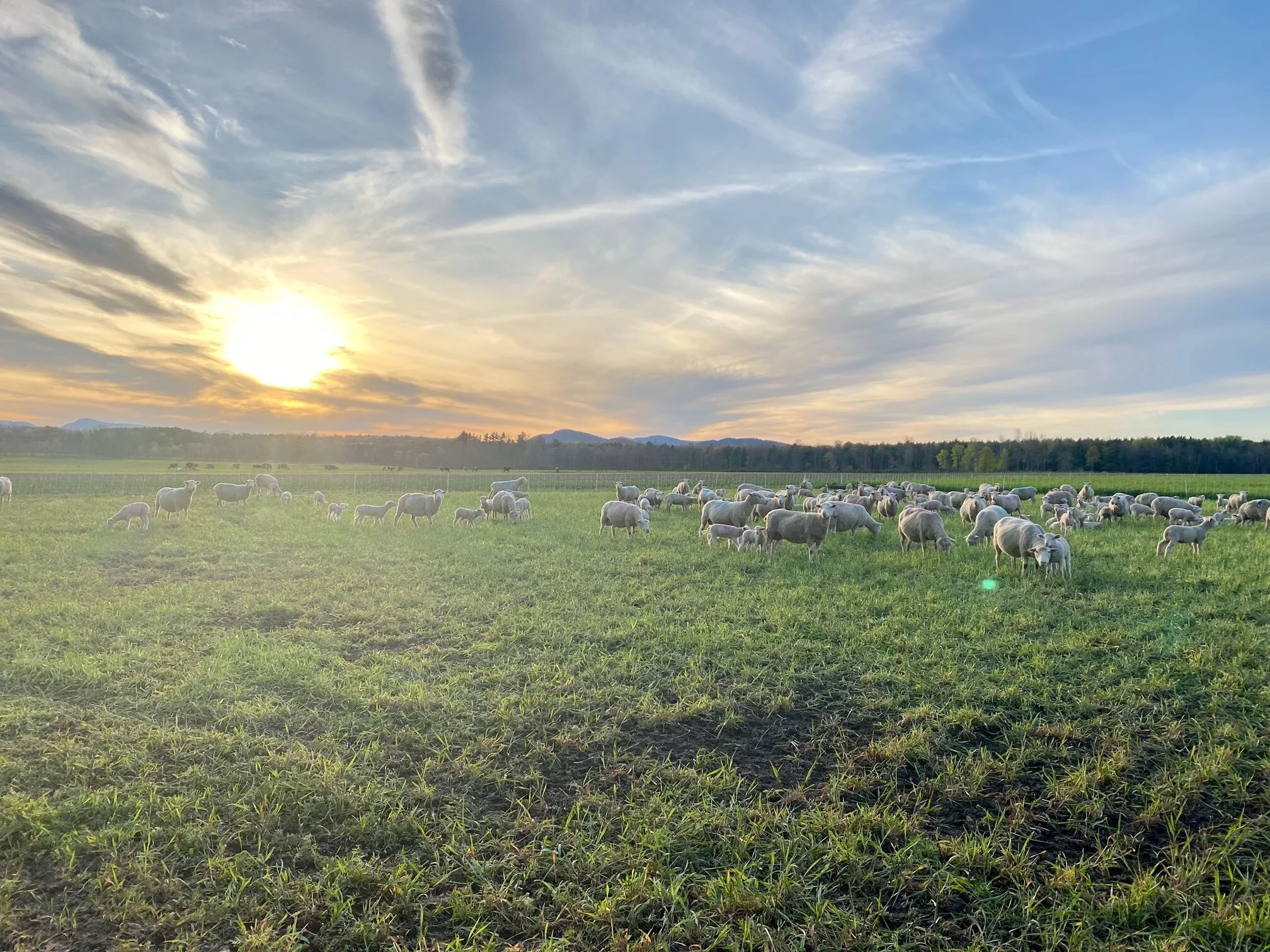Still lambing
Week 18, 2021
A light frost this morning on the grass and fruit blossoms, a dusting on the just-breaking lilacs. I like these days of unpredictable weather, when bouts of rain and chill are interspersed by blue-skied glory. You don’t take a beautiful day for granted when it's tucked between stacks of cloud. I’m scanning the ground for morels, which come on the heels of the lilacs. The ravens in the rafters are getting ready to fledge. And there’s the latest pair of twin lambs on the ground this morning, making our lamb count 240 over an excruciatingly long lambing season -- seven and a half weeks and counting, with about 40 ewes to go.
The last part of lambing brings a disproportionate percentage of the year’s problems. These are the ewes that didn’t breed right away, and whatever caused that relative weakness can cause other complications. Right now in the barn we have three ewes with mastitis, a ewe who is rejecting one of her perfectly nice twins, and a heavily pregnant ewe that has a case of JNR (Just Not Right). Overall, though, it has been a remarkably smooth year. We’ve lost very few lambs and have no orphans.
I learn so much about sheep every year, every lambing. A week ago there was a ewe that caught my eye at last check. What was it? Nothing specific to point to. An expression, almost of embarrassment, of wanting to hide herself a little, tucked among the rest of the flock. That made me look closer, and I saw a bit of blood on her rear, in my headlamp’s beam. Blood is normal after a birth but not before. It can indicate a breech lamb. A quick feel told me she wasn’t dilated yet, so I got her into a jug, and set my alarm for midnight.
I’d hoped I’d come back to find her happily licking a newborn, which would mean I could turn around and head back to my warm dry bed, but alas she was still alone in the jug, wearing that too-quiet look. This time she was dilated and I could feel what was happening. Rather than two feet and a nose it was indeed the soft rounded surface of a rear end I felt first, and next to it and just behind it, the hard wedge of a little head. More than one lamb, then, with a breech lamb cork. You can pull a feet-first breech without a lot of trouble, but a butt or a back is just not going to fit. It took a while to push the breech lamb deeper, hook the rear legs with a finger and bring them around, then cajole the breech lamb out without wedging the head-first lamb behind it into the bottleneck of the pelvis. Breech, unlike other births, should be done quickly, because the umbilical cord is likely to snap and then the lamb, still with its head in the ewe, will breathe fluid and drown. I tried, but I was not fast enough. When I got the lamb out it took a few weak breaths and was still. Back in then, for the front facing lamb, who came easily, and breathed, and then bleated, to the great delight of the tired ewe, who set right to work cleaning him off. A quick pull on the ewes teats told me she had milk, and I headed back to bed, leaving her nickering over her hard-won prize, confident they’d be fine. And they were. It turned out, though, there was a third lamb in there, but I didn’t know it until morning, when Anne found it dead in the jug. I hadn’t thought to check after the second was out. That’s what I mean about learning something every time. I’ll never make that mistake again.
I’m happy to report to Baby Z’s fans that she is well and thriving with her adopted family. I went out with Mark yesterday evening to move the flock to fresh pasture and saw her zip by, oblivious to me instead of dependent. Mark and I marveled at how big and fat the lambs are getting. The ewes are eating like dairy cows, on the sort of tender, leafy, bright green forage that makes lots of milk. Even the ewes raising triplets are holding decent body condition.
Meanwhile, the early vegetables are coming along. Soon the trickle will be a flow and then a torrent. But for now, they are still a trickle. Nothing wants to grow very fast in these cool temperatures. Radish and spinach and scallions and spring herbs have been lovely. Head lettuce and asparagus are on their way. We have plenty to feast on, though, and the milk is at its best in May because the grazing is so good.
We welcomed new farmers this week. Ben starts now, and comes with his partner Alice, who might be convinced to jump in every once in a while. Hugo will start in the fall. It’s good to have new faces on the farm and fresh hands at work. Which reminds me: we need housing for farmers! Please get in touch if you know of available rentals. And we have local and delivered shares available so please help spread the word.
That’s the news for Essex Farm for this May-frost 18th week of 2021. Mark says enough with the sheep already, so next time I’ll try to focus on other parts of the farm. Meanwhile, find us at 518-963-4613, on Instagram at kristinxkimball, essexfarmcsa and farmerkimball, or on the farm, any day but Sunday.
-Kristin & Mark Kimball
